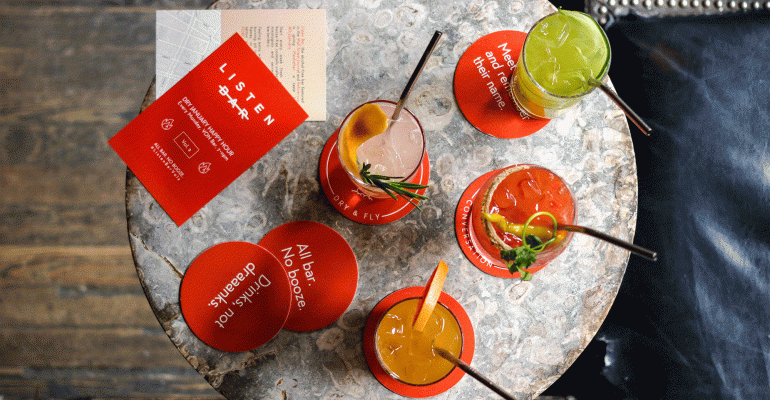 Kruse Company president Nancy Kruse kicks the conversation off:
Kruse Company president Nancy Kruse kicks the conversation off:
We’re suddenly working in an industry of exclamation points, Bret, that signal the absolutely, positively unprecedented nature of the product or service they punctuate.
CBD and THC! Impossible and Beyond! Grub Hub and ghost kitchens!
Okay, so the exclamations aren’t literally there, but they are implied by the tons of often unfiltered hype that surrounds them.
I bring this up because of the extraordinary hyperbole that has afflicted the beverage category, which is also awash in unbridled overkill. The source of all the excitement is the emergence of a social phenomenon dubbed variously “sober-curious,” the “new sobriety” or “mindful drinking,” and it is used hand-in-glove in discussions of the emerging low alcohol-by-volume (ABV) drink options.
Consider just a handful of recent takes on the subject:
In August, Esquire magazine asked rhetorically “What Comes After the Spiked Seltzer Bubble Bursts?” as the author recited trendy quaffs of summers past, like hard root beer in 2016, the Aperol spritz in 2017, frosé in 2018 and this year’s runaway hit, hard seltzer. This latter category is led by White Claw, whose young proponents say they’re “clawing” as they throw back cans of the 5% ABV come in fruity flavors like black cherry and mango. They’ve been clawing so assiduously that the manufacturer recently announced that supplies have temporarily run dry. By the way, the article introduced me to the evocative expression “share of throat.” It is the liquid equivalent of our share of stomach, and I’m surprised I hadn’t heard it before.
Also in late summer, The Atlantic opined that “White Claw Is What Happens When Being Cool Becomes Exhausting.” The writer explains hard seltzer’s popularity is based on what it’s not, namely difficult or aspirational, and what it is, namely affordable, convenient, portable, low-calorie and healthy seeming, which sounds suspiciously like McDonald’s salad line to me. Anyway, the story includes phrases like “ironic remove” and “too-cool coastal creatives.” You’d better pass me a can, Bret, as I find myself struggling to maintain my own non-ironic coolness as I write this.
But wait, there’s more, as the Washington Post weighed in with “The Key to White Claw’s Surging Popularity: Marketing to a Post-Gender World” and split the difference with The Atlantic by dubbing the product both aspirational and ironic. The ponderous “post-gender” reference simply refers to the fact that the drink is consumed equally by both men and women and quotes an amusing one-liner about how even the bro-iest guys imbibe it because “it’s like Perrier that does squats.”
NRN, of course, has covered the subject, notably with David Flaherty’s recent piece in which he keeps his adjectives and ironies in check, speaks to real restaurateurs and makes some very astute observations. Predictably, you were out ahead of the curve late last year, when you wrote about “mixing less potent potables.” The piece was similarly smart, sensible and business based, despite the earnest declaration from the Denver operator that he’d prefer two sherry cobblers over one Manhattan almost any day. I found this profoundly dispiriting, pun intended, and I hope that someday he sees the error of his ways.
Anyway, I could go on to discuss related product phenomena, like spiked cold-brew coffee in cans or wine water. Yes, the latter is a thing, and, yes, it’s made from gussied-up water. In this case it’s infused with the flavor of discarded grape skins used in the winemaking process and said to be totally lacking in alcohol on the one hand, but full of antioxidants on the other.
By now you’re probably wondering where on earth all this is going, and I confess that I bring up the topic partly because I appear to be the only writer in our galaxy who hasn’t tossed in her two cents on the topic. But in addition to validating my low-ABV wokeness, I have another, more substantive motive. You’re better versed on the beverage category than I, and I’d like to get you take on a few things.
First, do you think we’d be enmeshed in this craze if not for Instagram and other speed-of-light digital communications that bestow instant cool? What if, let’s pretend, Zima, a low-ABV relic of a bygone era and butt of lots of jokes on late-night TV, were launched today and invited youthful digerati to, say, “Zima it up” or engaged legions of social-media influencers to “stack some Zs”? Would the brand story have a different ending?
I also wonder if you think that the current beverage trends are too hot not to cool down? I recall seeing research some years back in the midst of the Atkins diet trend that reported that dieters stayed with the program around 90 days and then fell off the low-carb wagon because they missed pasta. I mention this because of press reports that some spiked-seltzer devotees are surreptitiously slipping vodka into their cans, which sort of defeats their whole purpose, no?
In any case, Bret, it appears that low ABV equals high drama. Do you think these producers have truly captured lightening in a can? Or does all this heat and hype serve to signify a liquified version of the Atkins craze?
 NRN senior food & beverage editor Bret Thorn responds:
NRN senior food & beverage editor Bret Thorn responds:
Nancy, I think we have a few things going on here.
The hyperbole comes from the current penchant, among Millennials in particular, to declare just about anything they enjoy to be the Best. Thing. Ever!
That’s to be expected from an age group that has been praised for all accomplishments large and small. I still remember when my nephew — now a 20-year-old Gen Z chap, actually — went poopy in the potty for the first time. We were at an amusement park and everyone in line with us for whatever ride we were in line for erupted in cheering applause.
Maybe that’s not the best example, since toilet training is a momentous occasion in the life of a toddler, but you get the idea. I’m sure my nephew is thrilled that I’m reviving that memory.
At any rate, if everything you do is greeted with delirious excitement, something actually worthy of a bit of praise requires additional exclamation marks at the very least.
On top of that is the sensory overload of the current age. If you want to catch someone’s attention on their social media feed, you don’t really have time for subtlety or nuance and instead have to declare something a GOAT (greatest of all time)!!!
Then there’s just the cyclical nature of beverage trends. You mentioned Zima, but a decade or so before that were wine coolers, and a decade after there were “malternatives” like Smirnoff Ice, which at the time were regarded as a marketing ploy by liquor companies whose ability to advertise the harder stuff is legally restricted.
Hard seltzers seem to be the latest version of that — basically the beverage equivalent of music with a good beat that you can dance to: Straightforward, easy to enjoy, and not requiring much thought.
And between the time you wrote your comment and I wrote my response, The Boston Beer Company, which makes Samuel Adams beer, announced a deal with the National Hockey League that makes the beverage company’s Truly Hard Seltzer the official hard seltzer of the NHL.
But this time around I think there might be some other factors urging consumers toward light, uncomplicated drinking, including palate fatigue.
For years the public has been bombarded with high-proof wines and strong, hoppy beers. In the beer world, we went from India pale ale to double and triple IPAs, to beer aged in wine barrels and bourbon barrels, or flavored with pumpkin and then chocolate or yuzu or I have no idea what else. And then came sour beers that ranged from kind of refreshing if you only had one of them to mind-bogglingly complex and weird. Along with that came natural wines, which can be okay but sometimes come with wild yeast and wild flavors that make them challenging to enjoy and just about impossible to pair with food. Meanwhile, whiskey sales skyrocketed and heavy, boozy cocktails became more commonplace.
Maybe people just got tired of thinking so much about what they were drinking, and possibly working to convince themselves that they actually were enjoying it. I think the fact that we’re seeing a resurgence of lighter beer styles reflects that mood, too. So does the rapid increase in the U.S. consumption of Irish and Japanese whiskey, which are generally milder in flavor than their American and Scottish counterparts.
I think social media has had more of a role to play in the “sober-curious” movement, where Instagram influencers exhibit their glamorous, manufactured lives while drinking what we used to call “mocktails,” but are now “spirit-free cocktails.” It’s become something of a tribe, like practitioners of yoga or CrossFit.
One person I asked about the general trend toward sobriety among young people suggested it was because they’re going straight to opioids, but there are other prevailing trends at play. as you know, Nancy, we are seeing a genuine trend of people eating more healthfully, at least some of the time — skipping some of their meals of burgers, fries and shakes for something lighter. Dabbling in sobriety fits into that.
Social media also has allowed like-minded people to connect. Although that can, and often does, create an echo chamber of people amplifying their own conspiracy theories and other vitriol, it also means that people who don’t want to drink can discover that they’re not alone. They realize that they don’t have to drink, and that’s perfectly fine.
And restaurants are responding with alacrity. Many of them now have spirit-free drink menus with items like the Tea Totaler at Crawford & Sons in Raleigh, N.C., made with verjus, green tea, caraway and celery. New York-based restaurant chain Rosa Mexicano recently added a whole line of “spirit-free” drinks, listed below “spirited libations,” with iced tea and agua fresca as well as drinks like the Mango-Ginger Refresco with mango purée, lemon, chia seed and ginger beer.
There are now even alcohol-free bars, such Sans Bar in Austin, Texas, which opened in 2017, and Getaway Bar, which opened in Brooklyn, N.Y., in April.
Some people with genuine addictions have groused at the idea that sobriety is “trendy.” For them it’s a life-and-death struggle, and acting like it’s easy or fun is dishonest and insulting.
But the sober-curious aren’t the first non-drinking American tribe. The Straight Edge movement that spun off of Punk Rock culture in the 1980s is still out there, avoiding all mind-altering substances, and sometimes meat, too.
Indeed, vegetarianism and sobriety seem to go hand-in-hand, according to New York City chef John Fraser, who operates Nix, a high-end vegetarian restaurant, among others.
Fraser started dabbling in vegetarian cooking at his now-shuttered Dovetail years ago. In an attempt to draw traffic on quiet Mondays, he started offering a vegetarian menu on that night and he was discovered by a whole new set of Birkenstock-wearing clientele.
Fraser told me he didn’t even know that Meatless Monday was a thing, but he managed to cash in on it anyway.
He said that one major drawback was that people eating meatless meals tend to drink very little if at all.
As you know, Nancy, the percentage of actual vegetarians in the country isn’t growing much, but the number of people seeking to eat less meat is. It’s possible that drinkers are going down a similar path.
Nancy Kruse, president of the Kruse Company, is a menu trends analyst based in Atlanta and a regular contributor to Nation’s Restaurant News.
E-mail her at [email protected]
Contact Bret Thorn at [email protected]
Follow him on Twitter: @foodwriterdiary





